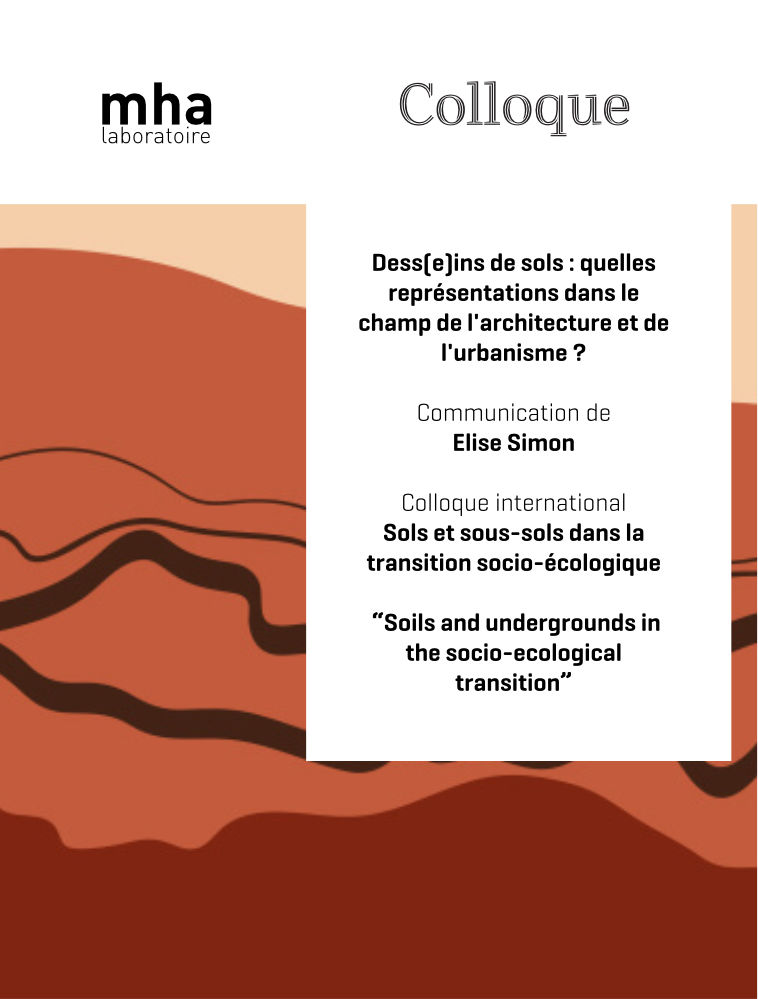Titre du colloque : Sols et sous-sols dans la transition socio-écologique / “Soils and undergrounds in the socio-ecological transition”
Dates : 9, 10 et 11 juin 2021
Le lien vers le site web du colloque : https://premc.org/sols-sous-sols/
Lien vers le programme : https://premc.org/sols-sous-sols/programme/
Titre de la communication :
Dess(e)ins de sols : quelles représentations dans le champ de l’architecture et de l’urbanisme ?
Résumé :
Attribuer un statut spécifique aux sols et sous-sols constitue l’une des dimensions fondamentales de l’établissement humain. Le dessin des paysages habités implique en effet la définition d’un rapport au sol, dans lequel s’articulent les enjeux de densité et de typologie bâties, de modes d’occupation et d’appropriation des sols, d’implantation des économies dans l’espace et dans le temps, qui configure les relations entre sociétés et environnement. La transition socio-écologique nous invite à reformuler les principes d’une économie générale de l’habitat à partir des modalités d’interaction entre sol, sous‑sol et établissement humain.
Cet article examine les concepts et représentations graphiques des sols et sous-sols dans l’histoire des théories architecturales et urbaines, à partir d’un corpus constitué de textes et documents dessinés depuis l’invention de la « science de l’urbanisation » au milieu du XIXe siècle jusqu’à aujourd’hui. L’analyse historique des notions et expressions graphiques utilisées par les architectes‑urbanistes permet de montrer qu’une conception du sol – entendu comme support des activités humaines ou comme écosystème de la biosphère – participe à configurer les conditions matérielles d’existence. Ces représentations reposent en outre sur des principes d’économie politique et d’économie de la nature.
En somme, l’évolution des représentations des sols, sous-sols et de leurs composants montre que la question foncière peut être appréhendée comme un « écosystème foncier », c’est‑à‑dire repensée à l’aune de sa complexité écologique, économique, politique et sociale.
Mots-clefs : rapport au sol, représentation, établissement humain, habitat, foncier
/ English version /
Soil designs: what representations in the field of architecture and urban planning?
Giving a specific status to soils and subsoils is one of the fundamental dimensions in the human settlement. The design of inhabited landscapes involves defining a relationship with the soil, in which many issues are concerned and articulated, such the density and built typology, modes of land occupation and appropriation, and location of economies in space and time. The definition of this relationship with the land issues shapes the links between societies and the environment. The socio‑ecological transition invites us to reformulate the basics of a general economy for the habitat based on the modalities of interaction between soil, subsoil and human settlement.
This article examines the concepts and graphic representations of soils and subsoils in the history of architectural and urban theories, based on a corpus of texts and drawn documents since the beginning of the “science of urbanization” in the second half of the 19th century to the present day. The historical analysis of the different notions and graphic expressions used by the architects and the urban planners shows that a perception of the soil – understood as a support for human activities or as an ecosystem of the biosphere – could participate in configuring the material conditions of existence. These representations are based on principles of political economics and nature’s economy.
In short, the evolution of representations of soils, subsoils and their components demonstrates that the land issue could be apprehended as a “land ecosystem”, which means redesigned in terms of its ecological, economic, political and social complexity.
Key-words: land relation, representation, human settlement, habitat, land tenure
